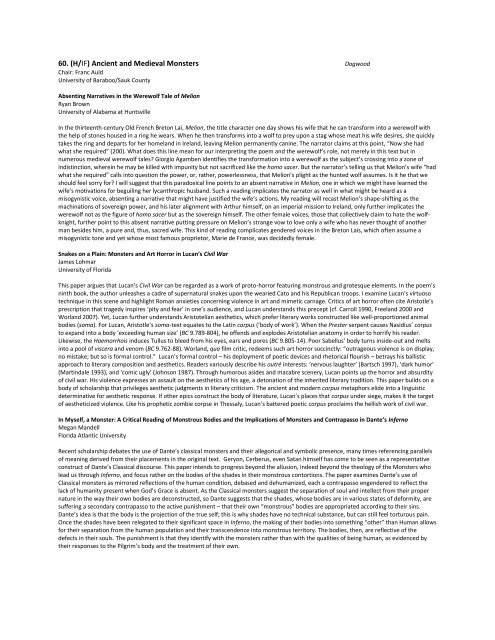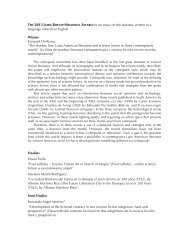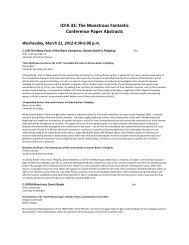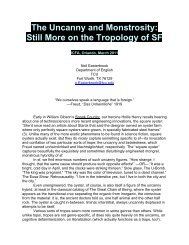The Monstrous Fantastic Conference Paper Abstracts - International ...
The Monstrous Fantastic Conference Paper Abstracts - International ...
The Monstrous Fantastic Conference Paper Abstracts - International ...
Create successful ePaper yourself
Turn your PDF publications into a flip-book with our unique Google optimized e-Paper software.
60. (H/IF) Ancient and Medieval Monsters DogwoodChair: Franc AuldUniversity of Baraboo/Sauk CountyAbsenting Narratives in the Werewolf Tale of MelionRyan BrownUniversity of Alabama at HuntsvilleIn the thirteenth-century Old French Breton Lai, Melion, the title character one day shows his wife that he can transform into a werewolf withthe help of stones housed in a ring he wears. When he then transforms into a wolf to prey upon a stag whose meat his wife desires, she quicklytakes the ring and departs for her homeland in Ireland, leaving Melion permanently canine. <strong>The</strong> narrator claims at this point, “Now she hadwhat she required” (200). What does this line mean for our interpreting the poem and the werewolf’s role, not merely in this text but innumerous medieval werewolf tales? Giorgio Agamben identifies the transformation into a werewolf as the subject’s crossing into a zone ofindistinction, wherein he may be killed with impunity but not sacrificed like the homo sacer. But the narrator’s telling us that Melion’s wife “hadwhat she required” calls into question the power, or, rather, powerlessness, that Melion’s plight as the hunted wolf assumes. Is it he that weshould feel sorry for? I will suggest that this paradoxical line points to an absent narrative in Melion, one in which we might have learned thewife’s motivations for beguiling her lycanthropic husband. Such a reading implicates the narrator as well in what might be heard as amisogynistic voice, absenting a narrative that might have justified the wife’s actions. My reading will recast Melion’s shape-shifting as themachinations of sovereign power, and his later alignment with Arthur himself, on an imperial mission to Ireland, only further implicates thewerewolf not as the figure of homo sacer but as the sovereign himself. <strong>The</strong> other female voices, those that collectively claim to hate the wolfknight,further point to this absent narrative putting pressure on Melion’s strange vow to love only a wife who has never thought of anotherman besides him, a pure and, thus, sacred wife. This kind of reading complicates gendered voices in the Breton Lais, which often assume amisogynistic tone and yet whose most famous proprietor, Marie de France, was decidedly female.Snakes on a Plain: Monsters and Art Horror in Lucan’s Civil WarJames LohmarUniversity of FloridaThis paper argues that Lucan’s Civil War can be regarded as a work of proto-horror featuring monstrous and grotesque elements. In the poem’sninth book, the author unleashes a cadre of supernatural snakes upon the wearied Cato and his Republican troops. I examine Lucan’s virtuosotechnique in this scene and highlight Roman anxieties concerning violence in art and mimetic carnage. Critics of art horror often cite Aristotle’sprescription that tragedy inspires ‘pity and fear’ in one’s audience, and Lucan understands this precept (cf. Carroll 1990, Freeland 2000 andWorland 2007). Yet, Lucan further understands Aristotelian aesthetics, which prefer literary works constructed like well-proportioned animalbodies (soma). For Lucan, Aristotle’s soma-text equates to the Latin corpus (‘body of work’). When the Prester serpent causes Nasidius’ corpusto expand into a body ‘exceeding human size’ (BC 9.789-804), he offends and explodes Aristotelian anatomy in order to horrify his reader.Likewise, the Haemorrhois induces Tullus to bleed from his eyes, ears and pores (BC 9.805-14). Poor Sabellus’ body turns inside-out and meltsinto a pool of viscera and venom (BC 9.762-88). Worland, qua film critic, redeems such art horror succinctly: “outrageous violence is on display,no mistake; but so is formal control.” Lucan’s formal control – his deployment of poetic devices and rhetorical flourish – betrays his ballisticapproach to literary composition and aesthetics. Readers variously describe his outré interests: ‘nervous laughter’ (Bartsch 1997), ‘dark humor’(Martindale 1993), and ‘comic ugly’ (Johnson 1987). Through humorous asides and macabre scenery, Lucan points up the horror and absurdityof civil war. His violence expresses an assault on the aesthetics of his age, a detonation of the inherited literary tradition. This paper builds on abody of scholarship that privileges aesthetic judgments in literary criticism. <strong>The</strong> ancient and modern corpus metaphors elide into a linguisticdeterminative for aesthetic response. If other epics construct the body of literature, Lucan’s places that corpus under siege, makes it the targetof aestheticized violence. Like his prophetic zombie corpse in <strong>The</strong>ssaly, Lucan’s battered poetic corpus proclaims the hellish work of civil war.In Myself, a Monster: A Critical Reading of <strong>Monstrous</strong> Bodies and the Implications of Monsters and Contrapasso in Dante’s InfernoMegan MandellFlorida Atlantic UniversityRecent scholarship debates the use of Dante’s classical monsters and their allegorical and symbolic presence, many times referencing parallelsof meaning derived from their placements in the original text. Geryon, Cerberus, even Satan himself has come to be seen as a representativeconstruct of Dante’s Classical discourse. This paper intends to progress beyond the allusion, indeed beyond the theology of the Monsters wholead us through Inferno, and focus rather on the bodies of the shades in their monstrous contortions. <strong>The</strong> paper examines Dante’s use ofClassical monsters as mirrored reflections of the human condition, debased and dehumanized, each a contrapasso engendered to reflect thelack of humanity present when God’s Grace is absent. As the Classical monsters suggest the separation of soul and intellect from their propernature in the way their own bodies are deconstructed, so Dante suggests that the shades, whose bodies are in various states of deformity, aresuffering a secondary contrapasso to the active punishment – that their own “monstrous” bodies are appropriated according to their sins.Dante’s idea is that the body is the projection of the true self; this is why shades have no technical substance, but can still feel torturous pain.Once the shades have been relegated to their significant space in Inferno, the making of their bodies into something “other” than Human allowsfor their separation from the human population and their transcendence into monstrous territory. <strong>The</strong> bodies, then, are reflective of thedefects in their souls. <strong>The</strong> punishment is that they identify with the monsters rather than with the qualities of being human, as evidenced bytheir responses to the Pilgrim’s body and the treatment of their own.





